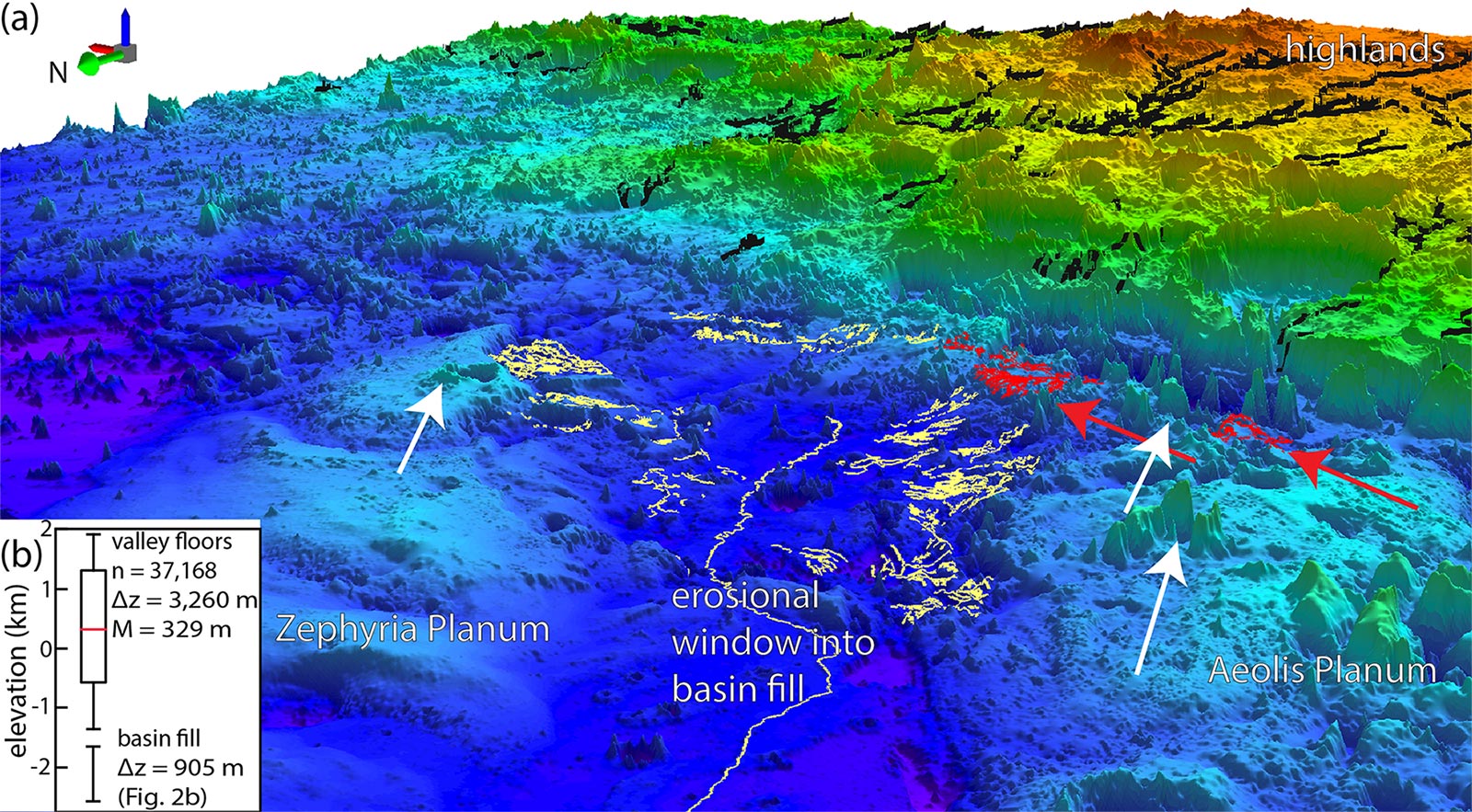Unida a partir de 28 imágenes, esta vista del rover Curiosity Mars de la NASA fue capturada después de que el rover subiera la empinada pendiente de una característica geológica llamada «Greenheugh Pediment». En la distancia, en la parte superior de la imagen, se encuentra el suelo del cráter Gale, que se encuentra cerca de una región llamada Aeolis Dorsa que, según los investigadores, alguna vez fue un gran océano. Crédito: NASA/JPL-Caltech/MSSS
Nueva evidencia de un antiguo océano del norte[{» attribute=»»>Mars has been uncovered in a recently released set of topography maps. These maps offer the strongest case yet that the planet once experienced sea-level rise consistent with an extended warm and wet climate, which was far different than the harsh, frozen landscape that exists today.
“What immediately comes to mind as one the most significant points here is that the existence of an ocean of this size means a higher potential for life,” said Benjamin Cardenas, assistant professor of geosciences at Penn State and lead author on the study recently published in the Journal of Geophysical Research: Planets. “It also tells us about the ancient climate and its evolution. Based on these findings, we know there had to have been a period when it was warm enough and the atmosphere was thick enough to support this much liquid water at one time.”
Whether Mars had an ocean in its low-elevation northern hemisphere has long been debated in the scientific community, Cardenas explained. Using topography data, the research team was able to show definitive evidence of a roughly 3.5-billion-year-old shoreline with substantial sedimentary accumulation, at least 900 meters (3,000 feet) thick, that covered hundreds of thousands of square kilometers.
Un conjunto de mapas topográficos publicado recientemente proporciona nueva evidencia de un antiguo océano del norte en Marte. Benjamin Cardenas, profesor asistente de geociencias en Penn State, dice que los mapas ofrecen el caso más sólido de que el planeta alguna vez experimentó un aumento del nivel del mar consistente con un clima cálido y húmedo prolongado, no el paisaje duro y helado que existe hoy. Crédito: Penn State
«Lo más grande y nuevo que hicimos en este artículo fue pensar en Marte en términos de estratigrafía y registros sedimentarios», dijo Cárdenas. “En la Tierra, rastreamos la historia de las vías fluviales al observar los sedimentos que se depositan con el tiempo. A eso lo llamamos estratigrafía, la idea de que el agua transporta sedimentos y que se pueden medir los cambios en la Tierra al comprender cómo se acumulan los sedimentos. Esto es lo que hicimos aquí, pero es Marte».
Usando un software desarrollado por el Servicio Geológico de los Estados Unidos, el equipo de investigación generó mapas con datos de la Administración Nacional de Aeronáutica y del Espacio ([{» attribute=»»>NASA) and the Mars Orbiter Laser Altimeter. They discovered over 6,500 kilometers (4,000 miles) of fluvial ridges and grouped them into 20 systems to show that the ridges are likely eroded river deltas or submarine-channel belts, the remnants of an ancient Martian shoreline.
Elements of rock formations, such as ridge-system thicknesses, elevations, locations, and possible sedimentary flow directions helped the team understand the evolution of the region’s paleogeography. Now known as Aeolis Dorsa, the area that was once ocean contains the densest collection of fluvial ridges on the planet, Cardenas explained.

There has long been debate in the scientific community about whether Mars had an ocean in its low-elevation northern hemisphere. Using topography data, a Penn State led research team was able to show definitive evidence of a roughly 3.5-billion-year-old shoreline with substantial sedimentary accumulation, at least 900 meters thick, that covered hundreds of thousands of square kilometers. Credit: Benjamin Cardenas / Penn State
“The rocks in Aeolis Dorsa capture some fascinating information about what the ocean was like,” he said. “It was dynamic. The sea level rose significantly. Rocks were being deposited along its basins at a fast rate. There was a lot of change happening here.”
On Earth, the ancient sedimentary basins contain the stratigraphic records of evolving climate and life, explained Cardenas. If researchers want to locate a record of life on Mars, an ocean as big as the one that once covered Aeolis Dorsa would be the most logical place to start.
“A major goal for the Mars Curiosity rover missions is to look for signs of life,” Cardenas said. “It’s always been looking for water, for traces of habitable life. This is the biggest one yet. It’s a giant body of water, fed by sediments coming from the highlands, presumably carrying nutrients. If there were tides on ancient Mars, they would have been here, gently bringing in and out water. This is exactly the type of place where ancient Martian life could have evolved.”
Cardenas and his colleagues have mapped what they have determined are other ancient waterways on Mars. An upcoming study in the Journal of Sedimentary Research shows various outcrops visited by the Curiosity rover were likely sedimentary strata from ancient river bars. Another paper published in Nature Geoscience applies an acoustic imaging technique used to view stratigraphy beneath the Gulf of Mexico’s seafloor to a model of Mars-like basin erosion. The researchers determined that fluvial ridges, landforms found widely across Mars, are likely ancient river deposits eroded from large basins similar to Aeolis Dorsa.
“The stratigraphy that we’re interpreting here is quite similar to stratigraphy on Earth,” Cardenas said. “Yes, it sounds like a big claim to say we’ve discovered records of large waterways on Mars, but in reality, this is relatively mundane stratigraphy. It’s textbook geology once you recognize it for what it is. The interesting part, of course, is it’s on Mars.”
Reference: “Paleogeographic Reconstructions of an Ocean Margin on Mars Based on Deltaic Sedimentology at Aeolis Dorsa” by Benjamin T. Cardenas and Michael P. Lamb, 12 October 2022, Journal of Geophysical Research: Planets.
DOI: 10.1029/2022JE007390
The other coauthor on the JGR: Planets paper is Michael P. Lamb, professor of geology at Caltech. The work was funded by the National Aeronautics and Space Administration (NASA).

«Maven de internet exasperantemente humilde. Comunicadora. Fanático dedicado al tocino.»
También te puede interesar
-
La NASA está cerca de decidir qué hacer con la problemática nave espacial Starliner de Boeing
-
Estas imágenes en primer plano del Sol son tan locas que no creerás que son reales
-
Científicos reales vivieron durante un año en un Marte falso en un cobertizo en Texas
-
Una serpiente de 34 millones de años descubierta en Wyoming cambia nuestra comprensión de la evolución
-
Los chimpancés comparten el estilo de conversación «apresurado» de los humanos

